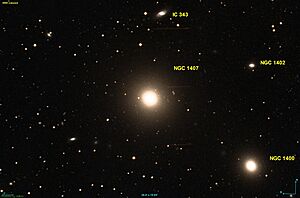NGC 1407 facts for kids
NGC 1407 is a type of galaxy called an elliptical galaxy. It can be found in the Eridanus constellation, which is also known as "The River." This amazing galaxy is very far away from our own Milky Way galaxy, about 76 million light-years distant.
Contents
What is NGC 1407?
NGC 1407 is a large galaxy that looks like a giant, fuzzy ball or an oval shape. It's part of a group of galaxies called the Eridanus Group. Imagine our Milky Way galaxy, which is a spiral, but then picture a galaxy that's more like a giant, smooth egg – that's an elliptical galaxy!
Where is the Eridanus Constellation?
The Eridanus constellation is a long, winding constellation in the southern sky. It looks like a river flowing through the stars. You can see it best during the autumn and winter months in the Northern Hemisphere, or during spring and summer in the Southern Hemisphere. NGC 1407 is just one of many interesting objects found within this starry river.
How Far Away is NGC 1407?
When we say NGC 1407 is 76 million light-years away, it means the light we see from it today started its journey 76 million years ago! A light-year is the distance light travels in one year. Light travels incredibly fast, about 300,000 kilometers (186,000 miles) per second. So, 76 million light-years is an enormous distance, showing just how vast the universe is.
Elliptical Galaxies Explained
Elliptical galaxies like NGC 1407 are one of the main types of galaxies in the universe. They are different from spiral galaxies, like our Milky Way, in a few key ways.
Shape and Stars
Elliptical galaxies have a smooth, oval shape, ranging from nearly perfectly round to very stretched out. They are usually made up of older stars, and they don't have much dust or gas left to form new stars. This is why they often look yellowish or reddish, as older stars tend to have these colors.
How Elliptical Galaxies Form
Scientists believe that many elliptical galaxies form when two or more spiral galaxies crash into each other and merge. This giant cosmic collision mixes up all the stars, gas, and dust, eventually settling into a smooth, oval shape. The process of merging can trigger a burst of star formation, but once the gas is used up, new star formation slows down.
Images for kids



